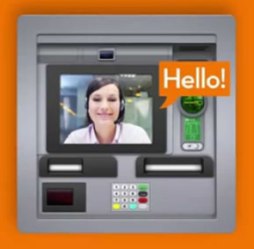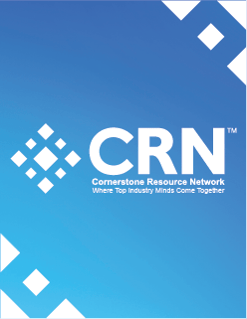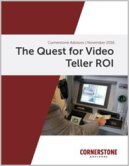10 min read
Are Video Teller Machines the ‘Branch of the Future?’
By: Ryan Rackley on Nov 29, 2016 3:38:22 AM
 The lowly ATM has been sitting in the corner for the last couple of decades, quietly doing its job. It hasn’t complained, it hasn’t called in sick. It’s always hungry for deposits and happily spits out cash. Over the last few years, however, we have seen a revolution in automated teller
The lowly ATM has been sitting in the corner for the last couple of decades, quietly doing its job. It hasn’t complained, it hasn’t called in sick. It’s always hungry for deposits and happily spits out cash. Over the last few years, however, we have seen a revolution in automated teller machine technology with the advent of deposit automation and video teller capabilities.
As banks and credit unions continually strive to find efficiency and differentiation in their branch networks, many are wondering if they should invest in video teller machines (aka interactive teller machines).
ITMs are basically ATMs with enhanced functionality, including video chat capabilities back to a centralized teller. ITMs require a significant capital investment, and investing in these machines has become a popular and controversial topic. Why are some FIs investing in ITMs and some are not? What is the return on investment? Are these machines essential to the “branch of the future?” Is there an alternative?
Video teller capabilities come in many different forms, and signing on for this new technology is far from a “no brainer” decision. To help FIs develop a business case for an investment in ITMs, here are GonzoBanker’s no B.S. pro and con considerations.
THE CASE FOR
Staffing Benefits
In a typical ITM-supported environment, tellers are consolidated into one or more centralized locations and have the ability to service multiple branches. In theory, this produces a queuing/efficiency benefit, the underlying promise of many ITM vendors. In reality, the ability to realize staff savings depends on the institution’s current staffing levels, level of integration, and strategy for customer introduction to ITMs. (Will the institution have dedicated staff teaching customers how to use these new machines? Will it force customers to speak with an employee via video for potential cross-selling?) In Cornerstone’s experience, it is more common for an FI to repurpose staff to greeting, platform and sales roles than it is to realize significant net staff saves.
Consolidating tellers can provide more benefits than just staff savings. Centralizing teller staff reduces turnover ratio, attracts higher quality applicants, and affords consistent training and communication of best practices, sales goals and promotions. Centralized locations can also be strategically placed for the benefit of recruiting and retaining better talent than might be available in certain branch locations/geographic regions (e.g., rural or expensive urban markets).
Incremental Sales
There are mixed opinions on whether implementing ITMs gives an FI the ability to produce incremental sales. In fact, we have not come across any data that shows there is a significant difference in sales performance between FIs with and without ITMs. But, for the sake of this discussion, let’s explore what might make an FI believe that implementing ITMs contributes to incremental sales.
Branches today typically have high cross-sell goals. Increasing sales with ITMs doesn’t happen from just demanding that staff make more cross-sells from walk-in/call-in traffic. Instead, it originates from a couple of fundamental changes in sales strategy:
1. Repurposing part or all of the full-time equivalent (FTE) employee savings from ITMs. This allocates benefits to sales roles and can free up time for outbound sales activities (e.g., hosting financial education seminars). Additional volumes are generated by increasing the number of FTEs focused specifically on sales and aligning compensation incentives to production goals.
2. Removal of manual cash handling. This has a positive effect on back office balancing procedures. Allow branch staff (who we no longer call tellers) to focus more on providing financial advice, community involvement, and driving brand awareness than on counting and handling cash. Also, drive-thru lanes with ITMs typically provide a better customer experience than transacting and communicating through the traditional vacuum tube system.
 Enabling the Transition to a Cashless Society with Efficiency
Enabling the Transition to a Cashless Society with Efficiency
Teller cash and check transactions are on the downturn and are inversely following the growth of debit and credit cards across the United States. How long it will take for the usage of cash to bottom out in our industry is anyone’s guess, but we know the trend will continue. As branches are already being run with bare minimum staffing at today’s volumes, leveraging ITMs in a cash-declining market can be an alternative strategy to drive efficiency. Branches have already begun their transformation from cash centric to account opening and advice centric. In our recent study, The Quest for Video Teller ROI, none of the financial institutions that have implemented ITMs experienced any measurable customer runoff.
Extended Hours
Branch locations without ITMs typically require two to four employees to operate each branch for extended hours. This is a very expensive value proposition. On the flip side, by leveraging the queuing benefits of ITMs, multiple branches can stay open later (in the drive-thru or vestibule) with significantly less staff while maintaining nearly full teller functionality.
Technology Perception/Digital Transition
There is a digital perception and branch of the future connotation that goes along with ITMs. Some perceive ITMs as an essential element of the branch of the future. Others view ITMs as an intermediary step to introducing branch-centric customers to a way of transacting digitally. As transactions migrate to digital channels without ITMs, the rationale is to essentially speed up the process for branch-centric customers while providing maximum customer retention and long-term cost savings by shrinking the cost of the branch network (size or number of locations).
THE CASE AGAINST
Economics
ITMs require significant capital investment, with total cost of ownership considerations drawing on people, process redesign, and technology resources. To reap staff savings, scale is the name of the game, and positive ROI is not a given. Producing staff savings based on reducing FTE headcount can require multiple machines and multiple locations.
Banks and credit unions have been working hard to drive efficiency in their branching strategies, pushing the incremental efficiency required for a positive ROI even further. An investment in ITMs requires hardware, software, installation, and maintenance costs, as well as the cost of training for video teller staff to operate them.
 Customer Transition
Customer Transition
A large majority of community and regional FIs differentiate themselves with outstanding personal service. ITMs change the customer experience, and resistance to change needs to be factored into this equation. Moving to video teller technology will require educating customers on how to use the machines and staffing branches appropriately to address transition periods.
ITM technology is new, and the industry is still figuring out how it will play out. Fast following banks and credit unions are learning as they go with this new technology. (See: Six Video Teller Mistakes to Avoid)
While ITMs are often viewed in isolation, they should really be used as part of a broader branch experience strategy or to solve a specific business problem like staffing. It’s important to remember, though, that an FI looking to solve a staffing issue with ITMs must realize that this particular technology is only one of numerous technology and process changes that can solve the problem.
Whether or not ITMs make sense for an FI depends on the institution’s retail/branch strategy, market opportunities, and current staffing levels. It’s a decision that warrants a much more carefully considered approach than “let’s buy one and see if it works.” It requires a business case that is part of the FI’s branch of the future strategy. It demands a broader justification than just ROI. Analyzing incremental benefits, costs, strategic alignment and customer impact to determine if ITMs make sense are key ingredients of this very high-stakes decision.
-Rackley
My thanks to Kaleb Seymour for his important contributions to this article.
The Quest for Video Teller ROI
In a recent study, Cornerstone Advisors uncovered the business cases and rationale behind the thinking of financial institutions that have deployed ITMs, and the operational performance, deployment issues and challenges the FIs experienced as a result of the technology.
Included in the report are performance metrics for capacity, cost and transaction ratios. Learn more
Smart Business Case Analysis = Smart Decisions
Before you buy your ITMs or invest heavily in an ATM refresh, consider a Video Teller and ATM Business Case Analysis from Cornerstone Advisors. Cornerstone can provide you with a best practices framework and methodology, and compare your data against peers and the market to produce a strategy that you can execute. Contact us today to learn more.
5 min read
The Holy Quest for CRM in Anytown, USA
Apr 25, 2024by Elizabeth Gujral
7 min read
Where Does Chime Go From Here?
Apr 4, 2024by Ron Shevlin

.png?width=1000&height=250&name=Cornerstone_Advisors_Logo-removebg-preview%20(1).png)



-2.png?width=247&height=320&name=MicrosoftTeams-image%20(36)-2.png)
-2.png?width=247&height=320&name=MicrosoftTeams-image%20(35)-2.png)
